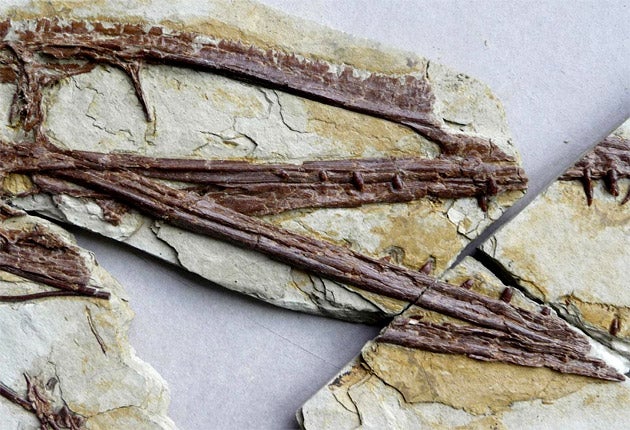Reptile fossils solve mystery that has baffled evolutionists
Remains provide link between long-tailed and short-tailed pterosaurs

An extraordinary flying reptile that lived around 160 million years ago has helped scientists to fill a gap in the fossil record that has frustrated scientists since the time of Charles Darwin.
The fossilised remains of more than 20 specimens of the flying reptiles – pterosaurs – were unearthed in China earlier this year. Dating has shown that they fall in the middle of the age range from 220 million to 65 million years ago when the pterosaurs evolved from primitive, long-tailed species to advanced, short-tailed forms.
The latest member of the pterosaurs, which has been called Darwinopterus modularis (Darwin’s wing) in honour of the father of evolution, has provided the first clear evidence for a controversial and unusual mode of evolution whereby entire “modules” of physical traits evolved in unison rather than as individual features.
Pterosaurs, which are sometimes known as pterodactyls, were the first animals with backbones that were known to take to the air in powered flight long before the appearance of the first birds. They had elongated fingers which were used to flap folds of membranous skin stretching to their legs.
They dominated the air when dinosaurs – which belonged to a different group of reptile – ruled the terrestrial environment. During that long period of some 155 million years pterosaurs evolved from predominantly long-tailed forms to short-tailed species but, frustratingly, no intermediate fossils had been found – until now.
The Chinese scientists who discovered and analysed the Darwinopterus fossils worked with British pterosaur expert David Unwin of Leicester University to work out how the species differed from its predecessors and descendants. The researchers concluded that the fossils demonstrate modular evolution, whereby the head and neck have evolved to look more like later species, whereas the long tail retains a more primitive appearance of the earlier pterosaurs.
“Darwinopterus came as quite a shock to us. We had always expected a gap-filler with typically intermediate features such as a moderately elongate tail – neither long nor short – but the strange thing about Darwinopterus is that it has a head and neck just like that of advance pterosaurs, while the rest of the skeleton, including a very long tail, is identical to that of primitive forms,” Dr Unwin said.
Some of the later species of pterosaurs, such as fearsome quetzalcoatlus, grew to gigantic sizes for flying animals, rivalling some of the largest birds today. Darwinopterus, however, was about the size of a crow and its rows of sharpened teeth suggest that it may have caught its prey on the wing.
“The geological age of Darwinopterus and bizarre combination of advanced and primitive features reveal a great deal about the evolution of advanced pterosaurs from their primitive ancestors,” Dr Unwin said.
The rate of evolution in Darwinopterus was probably fast with lots of big changes occurring over a relatively short period of time and, secondly, whole groups of features – modules – appear to have evolved together, although not all modules changed at the same time, he said.
“The head and neck evolved first, followed later by the body, tail, wings and legs. It seems that natural selection was acting on and changing entire modules and not, as would normally be expected, just on single features such as the shape of the snout, or the form of a tooth,” Dr Unwin said.
Pterosaurs died out at the same time as the dinosaurs, about 65 million years ago, when entire groups of animals were also lost in a global mass extinction. But the loss of the pterosaurs and the dinosaurs allowed the rise of the mammals and the birds, which filled the ecological niches on land and air.
“Frustratingly, these events, which are responsible for much of the variety of life that we see all around us, are only rarely recorded by fossils. Darwin was acutely aware of this, as he noted in the Origin of Species, and hoped that one day fossils would help to fill these gaps,” Dr Unwin said.
“Darwinopterus is a small but important step in that direction,” he said. The study is published in the Proceedings of the Royal Society B.
Writer's note:
Originally, there were several sub-editing errors in this piece (including the introduction of the word "carbon" by an over enthusiastic sub) which have been corrected by the author. Apologies.
Steve Connor
Join our commenting forum
Join thought-provoking conversations, follow other Independent readers and see their replies
Comments